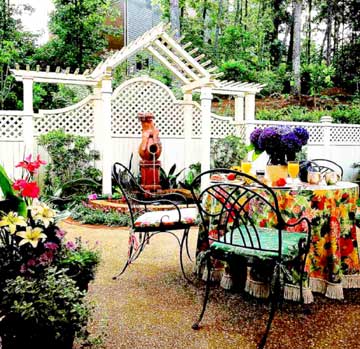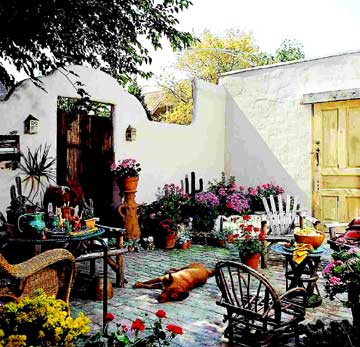





 Wrought-iron furnishings invite
alfresco dining, while a
terra-cotta waterfall makes the
destination soothing and secluded.
Wrought-iron furnishings invite
alfresco dining, while a
terra-cotta waterfall makes the
destination soothing and secluded.
What's exciting about a patio? It seems so passe -- just a boring slab of concrete that sits right outside a back door. Nothing about it beckons. Nothing about it inspires you to relish the outdoors.
At least that's what patios used to be. Today's versions are beyond bland. They now come in a variety of materials, from brick to flagstone to pea gravel, and they're less barren, too. People are starting to combine these outdoor floors with overhead structures such as gazebos and cedar pergolas. At the ground level, a proliferation of decorative containers makes it easier than ever to cozy-up these once plain slabs. With the right materials and decorative accents, a patio can become a backyard retreat that won't rot, attract termites, or require a fresh paint job or sealant every few years.
continue reading below Rustic furniture and
Southwestern-style plantings
make this Chicago retreat a
private getaway from the city
streets.
Rustic furniture and
Southwestern-style plantings
make this Chicago retreat a
private getaway from the city
streets.
The key to making a patio appealing is thinking of the space as an extra room. "One thing I love to do is make the patio an extension of the house," says Buck Buchan, a Kansas City, Missouri, landscape architect. "When you're in your house, your view is out onto the patio, so when we look out we need a focal point in our yard space.
Which is exactly what San Diego landscape architect Cindy Benoit created when she dressed up a client's yard with a formal, English-style wrought-iron gazebo that stands 9-1/2 feet tall and 7 feet wide. A wooden gazebo once stood in the patio's place, but it had rotted and was demolished. A focal point needed to fill this highly-visible spot in the house's expansive lawn, so Benoit asked herself what she would want in this space if she lived there. "I would want my morning breakfast and afternoon teas out there," she says. So she decided to create an outdoor room with a classic appeal that would draw the homeowners outside. She searched through garden catalogs for inspiration, and when she saw the formal English gazebo, she knew it was the sitting space's crowning touch. She draped the structure with white mosquito netting and decorated the pea-gravel flooring with wicker-and-iron furniture to complete the room's romantic-fantasy quality.
 Simple touches, such as a blue
water bottle, complement the
table's dishware.
Simple touches, such as a blue
water bottle, complement the
table's dishware.
Turning a terrace into a destination, such as Benoit did, is what transforms a patio into a backyard escape. Benoit and Buchan give their outdoor designs appeal by personalizing them. Buchan repeats fabric and accent colors from the home's interior to make the outdoors an extension of the house. Benoit includes some type of structure over or around a patio, such as a gazebo or fence, to define the site.
Both landscape architects try to work clients' personal items, such as a favorite birdbath or plant, into the patio's design to give the outdoor getaway character.
You're much more likely to use a room if it includes elements you love, such as your favorite color or favorite painting. That goes for patios, too. Following are some tips for turning these outdoor living spots into a personal paradise, from landscape architects Cindy Benoit and Buck Buchan:
Copyright © www.100flowers.win Botanic Garden All Rights Reserved